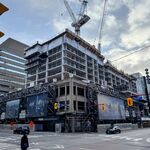sjc
Active Member
One of the major causes of congestion comes from people driving into work and parking downtown. Perhaps building some more large parking structures close to the highway (perhaps with direct access to the highway) would reduce the number of people driving around the streets of downtown. If you offer cheaper subsidized parking, people will walk a few blocks to their car.
This could take a lot of cars of downtown streets.
Similarly, expansion of parking at all GO stations (including those inside the city like Mimico) would also encourage people to drive to the train instead of driving downtown.
I'd also look at reconfiguring the Lakeshore and Gardiner so that one is exclusively eastbound and the other exclusively westbound. If you switched directions in the afternoon, you might be able to get away with leaving the Lakeshore non-controlled-access (Gardiner would be eastbound in the morning and westbound at night).
This could take a lot of cars of downtown streets.
Similarly, expansion of parking at all GO stations (including those inside the city like Mimico) would also encourage people to drive to the train instead of driving downtown.
I'd also look at reconfiguring the Lakeshore and Gardiner so that one is exclusively eastbound and the other exclusively westbound. If you switched directions in the afternoon, you might be able to get away with leaving the Lakeshore non-controlled-access (Gardiner would be eastbound in the morning and westbound at night).
Last edited:




